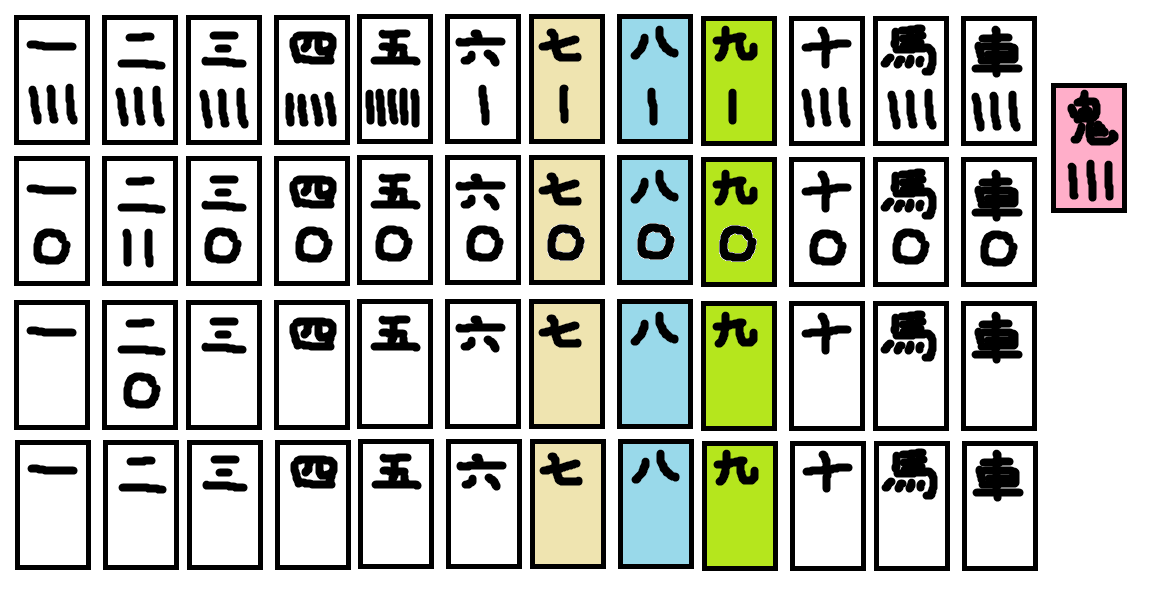
Shimafuda (島札, lit. “Island Cards"), also known as Jifuda (字札, lit. “Character Cards”) or Ichi-Ni-San (一二三, lit. “One Two Three”, not to be confused with the game of the same name) is a unique type of karuta whose structure is derived from Mekurifuda, that remained in Gushikawa, Uruma City, in the Okinawa prefecture of Japan.
A card manufacturer called Misumi Shoten (三角商店) manufactured these cards in Gushikawa until 1999. However in 2022, it was reprinted by Hisao Komino (小美野寿雄) in Oishi Tengudo, and sold at his Kotobuki Cafe & Game Bar in Tokyo. It was exhibited in April of that year in a large-scale “Tokyo Game Market” at Tokyo Big Sight, with great fanfare.
The cards were unique in that they do not bear any aesthetic derived from Portuguese playing cards; instead, they were replaced with Japanese characters. The numbers and points of each card were explicitly written on each card, which is in stark contrast to the design of Hanafuda, which uses flowers and animals/objects to hide the card numbers and points respectively.
It is used to play a mekuri game specifically designed for the deck, and because of it’s similarity to Hana-Awase, the deck was speculated to be a prototype of Hanafuda.
¶ The Cards
There are 48 cards in the deck, plus 1 Onifuda.
The deck has 12 numbers. Each number is indicated on the upper half of each card:
| NUMBER | Character |
|---|---|
| 1 | 一 |
| 2 | 二 |
| 3 | 三 |
| 4 | 四 |
| 5 | 五 |
| 6 | 六 |
| 7 | 七 |
| 8 | 八 |
| 9 | 九 |
| 10 | 十 |
| 11 (Horse) |
馬 |
| 12 (Chariot) |
車 |
| Onifuda | 鬼 |
The points of each card are denoted by either sticks or circles on the bottom half of each card.
There are 3 types of cards:
- Sticks - The number of sticks in each card denote the number of points. This type of card corresponds to the Brights/Animals of hanafuda cards.
- Circles - Worth 1 point each. This type of card corresponds to the Ribbons of hanafuda cards.
- Blanks - Worth 0 points. This type of card corresponds to the Chaff of hanafuda cards.
There are a total of 48 points in a 49-card Shimafuda deck.
¶ Number of Players
The game can be played by 3 or 4 people.
¶ Game Setup
¶ Equipment
All 49 cards of the Shimafuda deck are used (Onifuda included!).
It is possible to play this game using a hanafuda deck, but you have to know the Nagoya month sequence. Also, the Shirofuda may take place of the Onifuda.
Chips may be helpful for keeping track of scores.
¶ Choosing the Dealer
Each player draws a card from the deck. The player with the highest number becomes the dealer. If players are tied, they draw cards again.
¶ Dealing the Initial Cards
For 3 players: 7 cards are dealt to each player, and 7 cards face-up to the table.
For 4 players: 5 cards are dealt to each player, and 9 cards face-up to the table.
The remainder of the deck is placed face-down to form the draw pile.
What happens if 4 cards of the same number are dealt to the table has not been attested - usually a misdeal is declared (since these 4 cards are impossible to capture); In this case, the cards are thrown in, shuffled again, and re-dealt. Other rules should probably be agreed upon as a house rule.
Whether or not 4 cards of the same month in a player’s hand constitutes as a misdeal has not been attested - the specific answer to this question should probably be agreed upon as a house rule.
¶ Gameplay
Turns move in clockwise order, starting with the dealer.
The core gameplay is identical to Hana-awase, except that instead of matching flowers, numbers/courts are being matched instead.
The game ends when all players run out of cards in hand.
¶ Onifuda
The onifuda (red card) can be played by taking it alone into the capture pile (it doesn’t capture another card with it).
When the onifuda is in a player’s hand, it can be played during any of that player’s turns.
When the onifuda is drawn from the draw pile, it automatically goes to the capture pile.
If the onifuda appears on the field at the beginning of the round, the dealer takes it before starting their turn.
Note that the red color on the onifuda is only present on the 2022 Kotobuki version of the deck.
¶ Scoring
Each player’s card points are then counted and subtracted by a par score to get the settlement score.
Settlement score = Total of captured card points - Par Score
The par score for 3 players is 16 points; for 4 players, it is 12 points.
A negative settlement score means you lose those points; Positive settlement score means you win those points.
The player to the left of the dealer becomes the dealer for the next round.
¶ Yaku
In addition to the usual card point scoring, a player who forms a yaku receives 10 points from each of the other players for each yaku they make.
- Four Sevens (all four yellow cards)
- Four Eights (all four blue cards)
- Four Nines (all four green cards)
Note that colors on the cards are only present on the 2022 Kotobuki version of the deck.
¶ Number of Rounds
It is recommended to play in multiples of 3 rounds for 3 players, and in multiples of 4 rounds for 4 players, to make sure every player has an equal chance of being dealer.
¶ Bibliography
- Shimafuda Game Instructions, Kotobuki Cafe & Game Bar
- https://news.yahoo.co.jp/articles/940b5323c5115dec03dbbef1f1d5f7e4bbdfd317